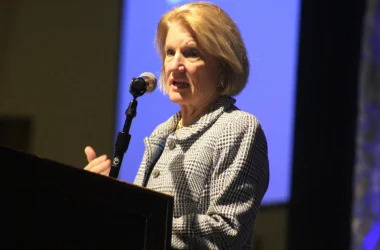By ERIN BECK
Charleston Gazette-Mail
FLATWOODS, W.Va. — Thursday morning and afternoon, employees of health departments from across West Virginia learned about how several health departments and other agencies in the state have tackled the opioid crisis by acknowledging that people addicted to drugs aren’t always equipped to change their behaviors.
Health department officials participated in a day-long meeting at the Days Inn in Flatwoods on a strategy called harm reduction. The model includes accepting that patients aren’t always willing or adequately prepared to change health behaviors — in this case, drug use — and that responsible public health interventions require meeting those people where they’re at and providing ways to minimize risk, such as: needle exchange programs; providing naloxone, a drug that reverses opiate overdoses, for first responders; and testing for viral infections that can be spread by sharing needles.
They heard how health officials in Cabell, Ohio, Monongalia and Jefferson counties have implemented harm reduction programs. Speakers encouraged attendees to implement programs in their own counties.
Angela Brown, a nurse practitioner at the Clay County Health Department, recorded what Dr. Kevin Yingling said about syringe exchange programs and other forms of harm reduction so she could play the recording for her board of health.
Clay County has no needle exchange, but it isn’t immune to the types of viral infections needle exchanges may keep from spreading.
Kanawha County has a needle exchange program, and in Kanawha County in 2015 there were three cases of acute hepatitis C reported, according to a report provided by DHHR spokeswoman Allison Adler. That’s equal to 1.6 cases per 100,000 people.
In Clay County, there were two cases reported. That’s equal to 22.4 per 100,000.
Reports from some other surrounding counties without programs showed: Roane, two cases, 13.9 per 100,000; Boone, four cases, 17.1 per 100,000; Putnam, one case, 1.8 per 100,000.
Jason Favor, too, planned to bring some of the information back to the board of health in Fayette County. Favor is the threat preparedness coordinator for the Fayette County Health Department.
In Fayette County, there was one case, equal to 2.2 per 100,000.
In Kanawha County in 2015, there were 71 cases of acute hepatitis B reported, equal to 37.7 per 100,000.
In Clay County, there were eight cases, equal to 89.8 per 100,000.
Some other surrounding counties showed: Roane, two cases, 13.9 per 100,000; Boone, 15 cases, 64.2 per 100,000; Putnam, 14 cases, 24.6 per 100,000.
In 2016, there were at least 615 overdose deaths involving at least one opioid in West Virginia, according to DHHR data provided by Adler.
County health departments that have operated harm reduction programs include Cabell, Kanawha, Ohio and Jefferson, according to Bill Kearns, president of the West Virginia Association of Local Health Departments.
Monongalia County also has one, at a free clinic. A Raleigh County doctor has also operated one. Adler said state officials are also aware of a program in Parkersburg.
That leaves 48 counties without programs. About 318 opiate-related overdoses occurred in 2016 in those counties, according to the DHHR.
Brown listened intently as Yingling, dean of the Marshall University School of Pharmacy and a member of the Cabell Board of Health, spoke about the challenges of convincing health departments to disregard the idea that needle exchanges encourage addiction, and to think in terms of costs. He said that Cabell County spends $100 million in an average year on the costs of addiction.
“What’s the legacy of your health department going to be?” he said.
Brown said that while Clay County doesn’t have the heroin problem Cabell County does, she wants to be proactive, and the area does have a pain pill problem. She also noticed that after devastating floods last summer, people are returning to old coping mechanisms.
“That’s the happiness that a pill could give them,” she said, “when they before could get it by life.”
Favor said that Fayette County has applied for a grant for naloxone to give to first responders. He wanted to suggest a needle exchange to the board of health, as well.
“What we have to do now is get the information not just to the public, but the board of health — the people that make decisions for those people,” he said.
Dr. Michael Brumage, executive director/health officer of the Kanawha-Charleston Health Department, called on health department officials to pool resources and form coalitions. He suggested that Thursday could be the first meeting of a statewide harm reduction coalition.
“This is the most-pressing public health problem, and it’s not going to go away,” he said. “If anything, it’s going to get worse before it gets better.”
Huntington Mayor Steve Williams urged the attendees to follow Cabell County’s lead.
He described receiving a series of cries for help from community members upon taking office, and first thinking that the drug crisis was up to the police.
“In each of your cities, you will hear someone say someone needs to do something, but not that,” he said.
He described seeing overdoses in people “as young as 8 or 9 years old, as old as in their 70s.”
“This hits me in my soul,” he said.
He said at the Cabell-Huntington Health Department, he found people who said “I’ll go in front of you.”
“This does not take courage,” he said. “It doesn’t take courage when you’re backed into a corner and there is no way out other than going straight ahead.
“We can be known as that state that figured out a way to defeat this.”
See more from the Charleston Gazette-Mail




